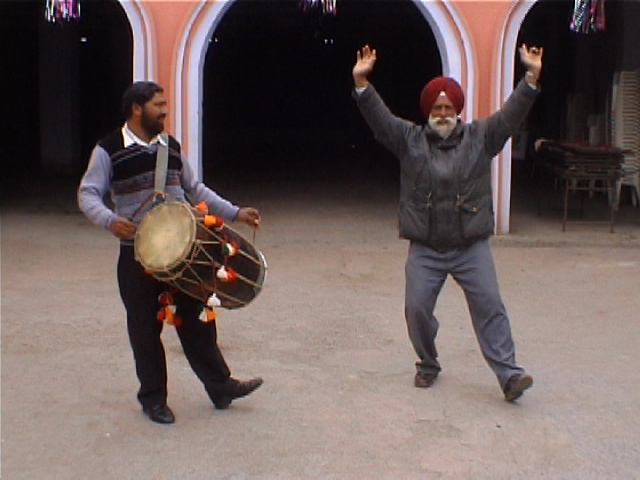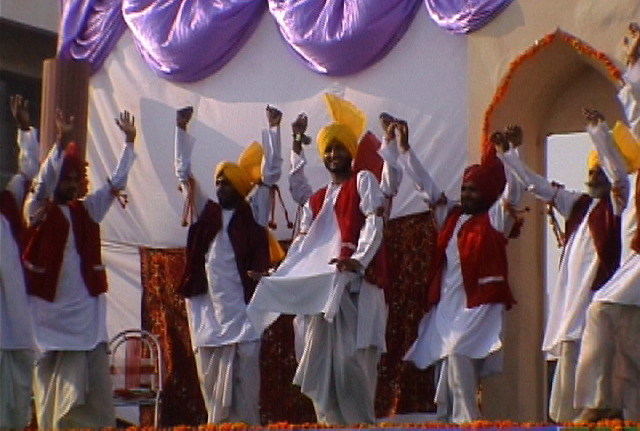I get lost in the back and forth, so I'll just restate briefly and try to clarify what I was talking about.
1. As I said, people in Diaspora (or in India for that matter) are welcome to do as they wish. And in fact in the context of modern stage bhangra, they really can't be doing traditional jhummar. It doesn't fit in, so trying is kind of futile. That's what I was saying. By the same token, it doesn't make sense to present what you're doing as something traditional. Be honest about it, and understand what you are doing.
2. The reason point #1 came up was because the OP was searching for the "correct" style. If one uses traditional jhummar to define "correct", one will only get caught on a slippery slope, because in investigating traditional jhummar, one will inevitably discover much more that is "incorrect" in bhangra's jhummar. It seems arbitrary to base that one aspect of one's dance on the traditional dance but nothing else. In my opinion, either shoot for the traditional dance wholeheartedly, or accept that you are doing something else and don't be disingenuous about it.
3. An aside: Without going too deeply into it, it's my belief that the new jhummar fad (yes, it was a fad) had much to do with reinscribing "traditionally" on modern bhangra (or on Punjabi dance generally). When many people are dancing it on stage, they seem to have a very strong sense that they are at that moment embodying tradition...and especially, marking the difference between themselves-- knowers of "authentic" Punjabi culture-- and others...others who might just be on the "bhangra" bandwagon, etc.
4. That sense of jhummar as a vehicle for the revival and/or assertion of traditionally is one that developed through a very specific history of jhummar in India in recent decades. It did not just appear out of nowhere.
5. One might imagine that the variations in jhummar that you see comes from the inherent variety of "folk" dance, due to the so called "folk process." "Folk process" refers to the idea that orally-transmitted, non-standardized folk performances naturally vary, kind of like The Telephone Game. Yes, these changes occur; the variety was there in traditional jhummar. However, the varieties of traditional jhummar do not really map onto current jhummar practices, so one can't rationalize what they are doing based on that...
6. Current jhummar practices (outside Pakistan) are mostly based in a few different phases of creation in post-Partition India.
Phase one - Early 1960s, one or two representative actions of "jhummar" got locked into the routine of staged "bhangra." This was done with stepping with the heel of the foot. Here again (from another thread) is my photo of Master Harbhajan Singh showing the step:
This got established as THE bhangra jhummar style. Harbhajan Singh, who grew up in a part of Punjab that had traditional bhangra dance, was very clear and without any shame told me that that area did not have a jhummar practice -- meaning that he had to learn and adopt this version of jhummar he was being given through the bhangra routine.
This step lasted well up through the end of the century.
Phase two - The jhummar group of Pokhar Singh, in far off Fazilka, had been maintaining a jhummar practice. This was stand-alone -- not part of bhangra. BUT although Pokhar Singh had danced traditional jhummar(s), keep in mind that by 1961 (IIRC), he had made up a standardized routine of staged jhummar. This is somewhat comparable to how a staged routine was developed for bhangra. Only in this case it was basically made up and doesnt seem to have changed much through the years.
Here's a picture I took of the group (after Pokhar Singh's death):
Pokhar Singh's group performed this routine here and there over the years. Again, this was aside from what was going on with bhangra. Bhangra practitioners, unless they had emigrated from Western Punjab, for the most part would have just accepted the "token" bhangra jhummar as what one was supposed to do. It was the only contact they had; it was there beginning and end of jhummar, and all dancers and dholis learned it.
But in 1985, Pokhar Singh's group was brought into the limelight for the North Zone Cultural Centre's inauguration. This and other Patiala institutions then got into promoting a jhummar revival. When Pokhar Singh's people performed, it was ok, but other people were evidently very presumptuously that they knew what was what (even though they might have only heard of the existence of jhummar very recently), and they did poor imitations. The Punjabi folklorist Prof. Nahar Singh derided the groups of this time as the Centre's "ill-trained lackeys."
Phase two and a half - Around this time Pammi Bai got attracted to jhummar. On one hand, he went to learn from Pokhar Singh. On the other, he was adapting jhummar
into his pop routines. Also, bhangra groups in his circle were trying out new jhummar
stuff by the 1990s. I don't have time to go into the details... but it seems to have been limited.
One thing that must be said is that jhummar, as adopted (appropriated?) by the mainstream, from glimpses of Pokhar Singh... often got matched -- erroneously -- to the dhol rhythm called tika-tik.
To be continued...



